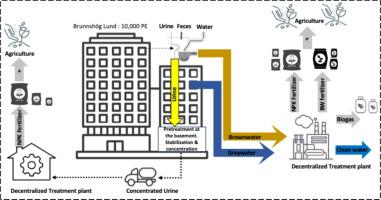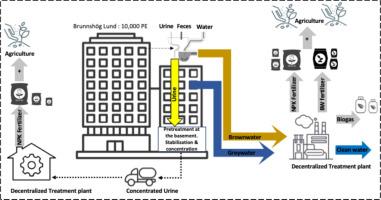Consequential life cycle assessment of urban source-separating sanitation systems complementing centralized wastewater treatment in Lund, Sweden
IF 11.4
1区 环境科学与生态学
Q1 ENGINEERING, ENVIRONMENTAL
引用次数: 0
Abstract
This study examined various source-separating sanitation systems to evaluate their environmental performance, providing decision-makers with insights for selecting an appropriate system for a newly developed neighborhood in Sweden. A full consequential LCA was conducted to account for resource recovery and substitution. The local wastewater treatment plant WWTP was modeled as a reference. Secondly, a urine recycling system was introduced to treat 75 % of the collected urine, with the remainder piped to the WWTP. Thirdly, a black and greywater (BW&GW) treatment system handling all generated wastewater was examined. Finally, a hybrid source-separating system combining urine, black, and greywater was investigated. The results indicated that the four scenarios exhibited global warming potentials (GWP) of 78, 62, 32, and 24 kg CO2-eq per PE/ y. Recycling urine as fertilizer led to a 20 % reduction in the GWP of the reference. It also reduced other impact categories, with a 55 %, 65 %, and 45 % reduction in eutrophication, ozone depletion, and acidification, respectively. The BW&GW system achieved a 60 % reduction over the reference GWP, mainly due to fertilizer, biogas, and cleanwater recovery. Integrating urine, black, and greywater recycling in the final scenario achieved a 25 % reduction compared to the BW&GW scenario, primarily due to lowering of the ammonia stripping GWP and the additional fertilizer recovery. Based on sensitivity analyses, switching citric acid for sulfuric acid reduced the GWP of the urine stabilization unit process by 101 %, from 15.47 to -0.14 kg CO2-eq per PE/ y. Ultimately, the findings suggest that the fully decentralized source-separating sanitation system incorporating urine, blackwater, and greywater recycling, particularly when combined with 70 % energy recovery at the urine concentrator, is most favorable.


对瑞典隆德市补充集中式废水处理的城市源分离卫生系统进行相应的生命周期评估
这项研究考察了各种源分离卫生系统,以评估其环境性能,为决策者提供见解,帮助他们为瑞典一个新开发的社区选择合适的系统。研究进行了全面的后果性生命周期评估,以考虑资源回收和替代。以当地的污水处理厂 WWTP 作为参考模型。其次,采用尿液回收系统处理 75% 的收集尿液,剩余尿液通过管道输送到污水处理厂。第三,对处理所有废水的黑水和灰水(BW&GW)处理系统进行了研究。最后,研究了尿液、黑水和中水混合源分离系统。结果表明,四种方案的全球升温潜能值(GWP)分别为 78、62、32 和 24 千克二氧化碳当量/年。它还减少了其他影响类别,富营养化、臭氧消耗和酸化分别减少了 55%、65% 和 45%。BW&GW 系统的全球升温潜能值比参考值降低了 60%,这主要归功于肥料、沼气和清洁水的回收。与 BW&GW 方案相比,在最终方案中整合尿水、黑水和灰水回收实现了 25% 的减排,这主要归功于氨汽提全球升温潜能值的降低和额外的肥料回收。根据敏感性分析,将柠檬酸换成硫酸可将尿液稳定装置工艺的全球升温潜能值降低 101%,从 15.47 kg CO2-eq per PE/y 降至-0.14 kg CO2-eq per PE/y。
本文章由计算机程序翻译,如有差异,请以英文原文为准。
求助全文
约1分钟内获得全文
求助全文
来源期刊

Water Research
环境科学-工程:环境
CiteScore
20.80
自引率
9.40%
发文量
1307
审稿时长
38 days
期刊介绍:
Water Research, along with its open access companion journal Water Research X, serves as a platform for publishing original research papers covering various aspects of the science and technology related to the anthropogenic water cycle, water quality, and its management worldwide. The audience targeted by the journal comprises biologists, chemical engineers, chemists, civil engineers, environmental engineers, limnologists, and microbiologists. The scope of the journal include:
•Treatment processes for water and wastewaters (municipal, agricultural, industrial, and on-site treatment), including resource recovery and residuals management;
•Urban hydrology including sewer systems, stormwater management, and green infrastructure;
•Drinking water treatment and distribution;
•Potable and non-potable water reuse;
•Sanitation, public health, and risk assessment;
•Anaerobic digestion, solid and hazardous waste management, including source characterization and the effects and control of leachates and gaseous emissions;
•Contaminants (chemical, microbial, anthropogenic particles such as nanoparticles or microplastics) and related water quality sensing, monitoring, fate, and assessment;
•Anthropogenic impacts on inland, tidal, coastal and urban waters, focusing on surface and ground waters, and point and non-point sources of pollution;
•Environmental restoration, linked to surface water, groundwater and groundwater remediation;
•Analysis of the interfaces between sediments and water, and between water and atmosphere, focusing specifically on anthropogenic impacts;
•Mathematical modelling, systems analysis, machine learning, and beneficial use of big data related to the anthropogenic water cycle;
•Socio-economic, policy, and regulations studies.
 求助内容:
求助内容: 应助结果提醒方式:
应助结果提醒方式:


